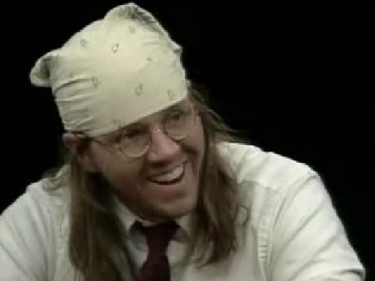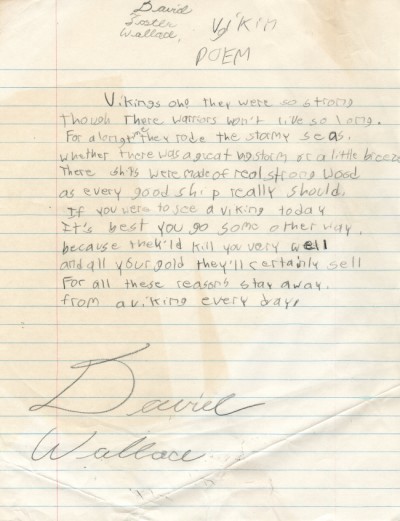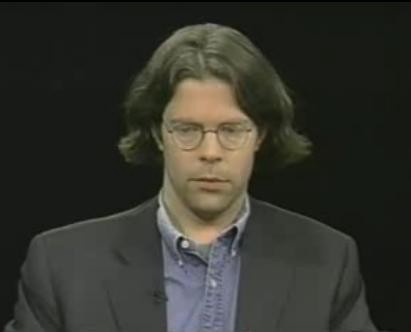46 Things to Read and See for David Foster Wallace's 50th Birthday

Today would have been David Foster Wallace’s 50th birthday, and if you’d like to mark it, here are some things that might interest you to read (or watch) and revisit. The list isn’t intended to be comprehensive; for that there’s the Howling Fantods, not to mention this, this and that. This is more like an old trunk, some favorite things that got packed away and today’s maybe a nice day to take them out and rummage around a little: Remember when Frank Bruni peeped inside DFW’s medicine cabinet? etc.
PIECES FROM AROUND
1. “Roger Federer as Religious Experience” at The New York Times (2006).
2–3. The fiction and essays for Harper’s, including: aboard the cruise ship Nadir, “Ticket To The Fair,” “The Depressed Person,” “Laughing With Kafka” and “Tense Present.” You can lose your morning here even if you’ve read them all before, and why not? “Just about every class has a SNOOTlet, so I know you’ve seen them — these are the sorts of six- to twelve-year-olds who use whom correctly and whose response to striking out in T-ball is to cry out ‘How incalculably dreadful!’ etc.” Or: “Hall shakes his gloves at the ceiling as several girls call his name, and you can feel it in the air’s very ions: Darrell Hall is going to get laid before the night’s over.” (Related: Jonathan Franzen’s disclosure that Wallace may have been loose with facts in his reportage.)
4. “Consider The Lobster” for Gourmet (2004).
5. “The Host” for The Atlantic (2005).
6. “Good Old Neon” isn’t available online (it’s in Oblivion); see instead this Ask MetaFilter question, “How do I stop being Neal from ‘Good Old Neon’?”
CHILDHOOD AND COLLEGE

7–8. “The Viking Poem,” written age 6 or 7, and “My mother works so hard,” probably earlier. (Via.)
9. An early, early 1987 profile of Wallace, written by Bill Katovsky, wherein he recalls childhood thusly: “It was an exceptional academic household. I remember my parents reading Ulysses out loud to each other when they went to bed. My father read Moby-Dick to my younger sister and me when we were 6 and 8. There was a near rebellion halfway through the novel. Here we were — still picking our noses — and learning the etymology of whale names.”
10. On his college self in “Brief Interview with a Five Draft Man,” an interview with Amherst’s alumni magazine: “I was one of those people they had to flicker the lights of Frost Library to get out of there on Friday nights who’d be out there right after brunch on Sunday waiting on the steps for them to open the doors.”
11. Some of his college humor writing with friend Mark Costello (co-writer on Signifying Rappers).
“HOW’S IT FEEL TO BE FAMOUS?”
12–13. Michael Pietsch’s editor letter to Wallace re: Infinite Jest; and a 2009 essay by Pietsch on what it was like to edit the book.
14–17. Michiko Kakutani’s mixed-but-engaged review of Broom Of The System was followed by the mixed-but-still-engaged review of Infinite Jest. In a Salon interview with Laura Miller, Wallace mentions the objection of the “very charming Japanese lady from the New York Times” to the novel’s heft. (The Pale King got a mixed-but-engaged reception, too.)
18. The big Frank Bruni Times Magazine profile, “The Grunge American Novel” (oh, grunge), that described riding in a taxi with Wallace to the packed KGB reading: “I have no saliva.” At the reading, Elizabeth Wurtzel was up front, “Ethan Hawke lurked in the back.” Back in Illinois with his friends: “Do you guys know ‘The Charlie Rose Show’? Would you think it was whorish if somebody went on it?”
19. On “The Charlie Rose Show” a couple months later with Jonathan Franzen (denim button-up with sports coat) and Mark Leyner (mob suit). Rose’s big question: In the age of the Internet, what’s the future of the novel? (Spoiler: the novel gives it all up to explore the jungles of Brazil.) The dynamics of male friendship and rivalry on display here are riveting; and Jonathan Franzen’s hair makes me regret that no one makes plaster busts of authors anymore.

20. Wallace, with the white bandanna, was on the show again a year later to talk about A Supposedly Fun Thing I’ll Never Do Again. Rose remains concerned about the novel’s chances against “the allure of technological advancements.” My favorite bit here is when they talk about movies.
21–22. These Bookworm interviews are also great.
23. While on assignment for Rolling Stone, David Lipsky spent five days with Wallace at the end of the Infinite Jest book tour. Wallace was a few years older than him. He talked about the “greasy thrill of fame” (“how’s it feel to be famous?” asked a FedEx guy as he was signing a package). Lipsky recounted his time with Wallace in “The Lost Years & Last Days of David Foster Wallace” for Rolling Stone (not offered online); and then more fully in Although Of Course You End Up Being Yourself, which is based almost entirely on their conversations. (It’s excerpted here, but you’re better off reading the book.)
24. This 1996 online conversation with Word e-zine is a hundred kinds of charming; there are maybe five or six youngish people in the chatroom with Wallace, and he’s really unguarded and fun with them.
dfw: In my very first seminar in college, I pronounced facade “fakade.” The
memory’s still fresh and raw.
Marisa: Keats, I don’t want to know about your problems and feelings.
dfw: I’d like to hear more about keats’s carbuncle, though.
Keats: *sniff* I only mentioned it because I thought it was relevant.
Keats: It’s actually more like a welt.
INDISPUTABLE FAME MARKER
25. Girlfriend Stops Reading David Foster Wallace Breakup Letter At Page 20, at The Onion (2003).
DISPUTABLE FAME MARKER
26. Being interviewed by German TV ZDF that same year.
THE 2005 KENYON COMMENCEMENT SPEECH
27–29. There’s a point (and maybe it’s already approaching) where this speech will seem too needlepointed and sampler-like to remain moving, but for now let’s say it’s not here. (Audio of Wallace delivering the speech, parts 1 and 2.)
FRIENDS, SLEEPING COMPANIONS AND ACQUAINTANCES
30. “Just Kids” by Evan Hughes, about the intertwining relationships between Jeffrey Eugenides, Franzen, Wurtzel, Rick Moody, Mary Karr, Costello and Wallace in the 80s.
31. 2001 piece by Zadie Smith for Eyeshot, then in the U.S. for her White Teeth book tour — if you’ve read it before, re-reading it may give you a whirling feeling of time-travel back to millennial-era Internet:
“So, says Lorrie [Moore], “Is there anyone you really like, who you really wanted to meet?”
Charged by caffeine, I tell her I want to meet David Foster Wallace. I want to meet him so much it’s giving me a hernia. I want to meet him so much that I have had a dream where I meet him sitting on the pavement and he says that we’ve already met and it wasn’t so great and neither of us had much fun and he doesn’t want his hair cut so why don’t I just go home and stop bothering him. In the dream I try to convince him that he could afford to lose at least six inches from underneath that bandana. Maybe we could even do something with the colour. But he walks away without a word. In this dream, I am around thirteen years old, and Mr. Foster Wallace is in his mid-twenties.
Lorrie Moore looks at me queerly. She says, “You know, he’s a perfectly nice guy — I’m sure it wouldn’t be so hard to meet him of you really wanted to.”
I also felt this way in 2001, Zadie.
32. A 2003 interview with Dave Eggers.
33. Above, video from the literary festival Le Conversazioni in 2006, where he appeared with Smith, Franzen, Eugenides and Nathan Englander.
34. Remembrances by former students, longtime readers and correspondents, fellow writers, people who had met him at readings — and a guy who played tennis against him in fifth grade.
DFW’S READING RECOMMENDATIONS
35. “Five direly underappreciated U.S. novels > 1960,” compiled for Salon:
“Wittgenstein’s Mistress” by David Markson (1988)
“W’s M” is a dramatic rendering of what it would be like to live in the sort of universe described by logical atomism. A monologue, formally very odd, mostly one-sentence 6s. Tied with “Omensetter’s Luck” for the all-time best U.S. book about human loneliness.
36. Circling back here to the interview by Laura Miller mentioned earlier, because it includes a really nice short riff on the writers whose stuff “historically… sort of rung my cherries”: “And, my God, there’s poetry. Probably Phillip Larkin more than anyone else, Louise Glück, Auden.”
37. “David Foster Wallace’s 10 favorite books,” topped by The Screwtape Letters.
38–39. Further reading can be cadged from this ’94 syllabus for Literary Analysis: Prose Fiction (Jackie Collins!) or this one for a Spring ’05 Literary Interpretation Syllabus (Coetzee and Silence of the Lambs).
(40. Related to his teaching, a 1987 student evaluation: “Jessamyn has more or less mastered, in the two best stories I saw, a kind of jaundiced, hostile young voice that is both completely convincing and engaging to read.”)
UNBEARABLE
41. D.T. Max’s New Yorker essay about Wallace’s struggle with depression. It came out, you’ll remember, six months after his suicide, and it catches everyone — Karen Green, his parents and sister, friends — in the mid-freefall of their grief, and it’s incredibly rough going — even with Mary Karr zinging up the place — and yet it’d feel wrong not to include it here. Max’s biography Every Love Story is a Ghost Story: A Life Of David Foster Wallace comes out this fall; I’m sure the book won’t lack for blurbs, but if for some reason one’s needed, “Unbearable … incredibly rough going” is now available.
IN THE ARCHIVES
42. The inventory of what’s at the Harry Ransom Center.
43. Some highlights of the archive:
In the margins to his personal copy of Lost in the Funhouse — written by an early pope of American postmodernism, John Barth — you can read along with Wallace as he bristles at the limitations of the high-academic style. Barth’s writing seems to him “Talmudic — obsessed w/its own interpretation” — a line that winds up, nearly verbatim, in the mouth of a Wallace character in the novella Westward the Course of Empire Takes Its Way. (Wallace also wrote character names and plot elements for Westward into the margins of Funhouse, making his copy of the Barth book both a mashup first draft and a vortexlike wormhole of 20th-century American fiction.)
44–45. “Inside David Foster Wallace’s Private Self-Help Library” by Maria Bustillos, published here last spring. (The books talked about in the piece have since been removed from the collection.)
THE ANXIETY OF INFLUENCE
46. And if during this list-making I’ve lapsed into any Wallace-ish phrasings I pretty much wouldn’t be the first.
